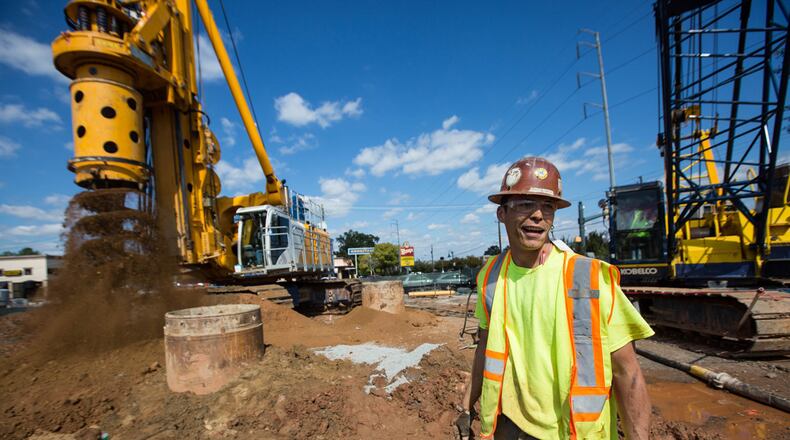In the past, downtowns were built near railroad depots, rivers or important crossroads where commerce was committed.
Recently, many of the newly created cities carved out of suburbia are looking to establish that downtown feel. But locating a downtown is different these days. Today, look for a Whole Foods or Sprouts Farmers Market and you’ll find an old-timey, but plush, city center going up.
Officials from the new cities have figured out what demographers for the high-end grocers already knew: people who will spend a little extra for New Zealand Grassfed Cheddar are likely to have discriminating taste and money to burn. So why not build town squares and keep those people spending their money near home?
Everyone these days seems to be envious of nostalgic downtowns like Decatur ‘s and Marietta’s. So cities that are seen as sprawling, faceless blobs are hurrying to create their own sense of shared place. New cities like Sandy Springs, Johns Creek, Peachtree Corners and Milton, as well as old suburbanized towns like Sugar Hill and Alpharetta want downtowns. It’s like a downtown arms race.
Currently, Sandy Springs is spending $220 million to create a 15-acre city center officially known as Stop Calling This the Former Target!!!
The site is on an insanely busy area on Roswell Road north of I-285 and sits on the highest point in the city. Mayor Rusty Paul is a man with vision and he likes what he sees.
“We get to look down on the city of Atlanta from there,” he said.
Sandy Springs, the first of the new cities, was created in 2004 and has been in a race with Atlanta to gobble up Fortune 1,000 headquarters. But despite the success in reeling in businesses, there is no there there when it comes to the heart of Sandy Springs. Paul is the first to admit it, "There is no central connective tissue where (residents) can come together as a community."
So, build an amphitheater and a new government center, throw in a meeting space, a few residential units and some retail and voila! you have the beginnings of a downtown.
Currently, the idea of bicycling or even walking around there is insane because you’ll get squashed by a speeding Lincoln Navigator faster than you can say “pedestrian friendly.” But they’re working on it. The center, Paul says, has helped persuade private developers to spend $500 million nearby. Soon, he hopes, the landscape will be thick with millennials, retired Boomers and families with double strollers all over the place.
Sure, some naysayers might say, “Hey, wait! Aren’t you a fiscally responsible, smaller-government government?”
Paul would say, yeah, but to make money you’ve got to spend money. “It you’re not remodeling yourself, you’re going to die,” he said.
A few minutes later up Ga. 400, I encountered the massive brick, columned edifice that is Alpharetta’s new City Hall. It’s a 50,000-square-foot building that still has that new drywall smell and is largely empty because it’s 50,000 square feet and this is still Alpharetta!
Mayor David Belle Isle, a real estate attorney by trade, stood like a proud papa on the balcony of City Hall and pointed to the new adjoining Fulton County library, a garden area and a 450-car parking garage. “I think it’s the prettiest (parking) deck in Georgia,” he said. It was modeled after one by UGA’s Sanford Stadium.
Trying to create a there there
Currently “downtown” is a couple blocks of one- and two-story buildings with straw-filled Halloween dummies out front, props that tell passing motorists, “These Alpharetta folks are fun!”
But in front of City Hall, there is a vast empty expanse of real estate with roads and sidewalks already in place. The landscapes says, “Someone’s gonna spend a bunch of money to develop this.”
It won’t be taxpayers, he said. They already did that to the tune of $30 million to prime the pump. Work is set to start next year.
Alpharetta is not a new city but, it feels like one. In 1980, there were 3,000 residents, Belle Isle said. Now there are 62,000. It’s a city fat with cash with tons of technology companies and other office centers. Two-thirds of its tax base comes from commercial interests. That’s good.
The mayor said he has repeatedly performed real estate closings with long time residents who did not know Alpharetta had a downtown. Now they’re flocking to special events like Food Truck Alley because people love lobster mac and cheese from a truck.
“There was nothing to market (as a city); we had nothing to identify with,” Belle Isle said. “We want people to connect as a hometown.”
Land of the Tastefully Built Strip Malls
I told him I was heading next to Johns Creek and he shook his head. “A city like Johns Creek is like, wow, they have some challenges,” he said. “Long, skinny. I couldn’t draw it on a map.”
You can say that again. Once, my sons and I caught a bunch of bullfrog tadpoles in an office park lake, raised them to froghood at home and then released them back to the pond. That's Johns Creek. But they're looking to change that.
The town, created in 2006, has a lot going for it. Large, tony homes. Nice lawns. Smooth roads. Leafy office parks. And no trash on the roads. Its slogan is “Land of the Tastefully Built Strip Malls.”
But a focus group recently spelled out some shortcomings: “No sense of identity.” “Difficulty finding way around.” “Lack of entertainment and eating options.” “Lack of character.”
Johns Creek aims to change all that. The dream is to use the 700-plus acres around the Technology Park area and turn it into a massive downtown area with a grid of streets, townhomes, offices, restaurants, perhaps a new city hall, canal walkways (yes, canals).
Yes, these guys are thinking big. They must. The city’s tax base is 80 percent residential, meaning the folks living in the those nice big homes here will one day have to pay a lot more in taxes if they can’t figure out a way for someone else to pay them.
To the south is the new city of Peachtree Corners, which bought a plot of wooded land along Peachtree Parkway to create a city center out of whole cloth.
A couple surveyors in orange vests were there and I stopped to chat and explain I was visiting future downtowns. I was scouting out Peachtree Corners’ space, I said.
The man shrugged with an uncomprehending look. “Where’s Peachtree Corners?” he asked.
I pointed to the trees.
About the Author
The Latest
Featured


